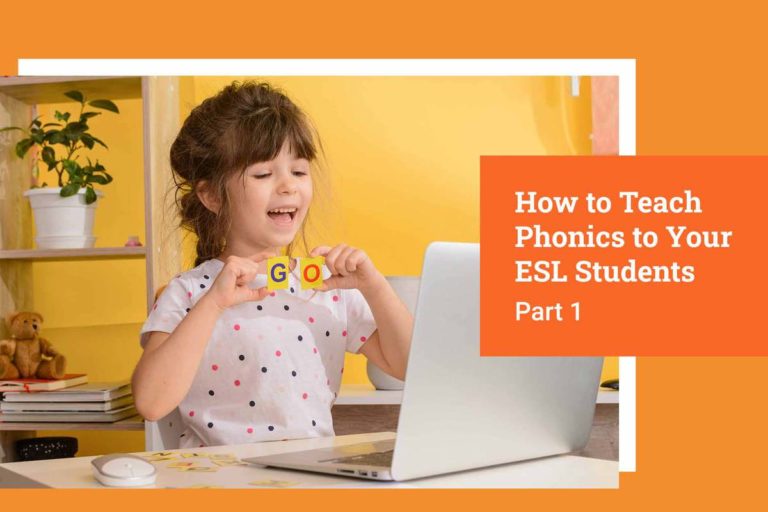Ready to start teaching English online?
Teach with VIPKidLooking for part one in our series on teaching phonics to ESL students? Check it out here.
Phonics is the backbone of learning English. Learning to read and write a language is just as important as learning how to listen and speak it! Let’s take a look at the top phonics teaching strategies for online English tutors, as well as some of the best online classroom phonics games.
Phonics Teaching Strategies
Utilize Visual Aids
VIPKid teachers know that visual aids can be a great way to reinforce learning when it comes to any subject. But when it comes to teaching reading and writing, visual aids are absolutely essential to the learning process. Using visual aids in your online classroom like pictures, manipulative letters, or simply circling letters within a word will help students create connections with the letters and their individual sounds.
Speak With Clear Pronunciation
Improving ESL students’ pronunciation might seem daunting if you’re a new teacher. But the best way to improve a student’s pronunciation is to focus on your pronunciation. Students will learn to repeat what they hear, so make sure what they hear is clear and consistent!
When teaching pronunciation, it’s also important to recognize potential challenges that can come with introducing new sounds. Avoid teaching letters with similar sounds at the same time. For example, many ESL students could have a hard time distinguishing the letter “D” with “T”, or sounds from similar consonant clusters like “SH” and “CH”. Introduce potentially confusing sounds during different lessons to make sure students can learn each sound individually.
Implement TPR
Total physical response (TPR) is a teaching method that combines instruction with body movements to create an engaging learning experience for students. When you’re teaching phonics in the online classroom, it’s a good strategy to act out and emphasize sounds letters make. Some examples would be a puff of air for the letter “P”, a slithering snake for the letter “S”, or a zipping up a jacket for the letter “Z”.
Repeat Sounds (Again, and Again… and Again)
Research has shown that in order to truly retain new information, humans need to hear it and repeat it around 30 times. But don’t don’t just stand in front of your students making the same letter sound until you’re blue in the face. When teaching a new sound, pronounce it clearly with your visual aid and take turns repeating it 5-7 times before moving on. Mix in some TPR to keep the lesson fun and keep students engaged, and have them continue practicing through classroom activities and games.
Speaking of phonics games for the online classroom…
Phonics Games
When teaching phonics, online classroom games are a great way to introduce themes and reinforce previous learning. Here are some of the best phonics games to play with ESL students.
Blending and Segmentation Games
Blending involves having your students put together (or “blend”) letters together to form a word. To play blending games with younger students, give them 6-8 letters and have them create as many three-letter CVC words as they can. With older students, give them an assortment of random letters and see who can create the longest word. As long as students are putting letters and sounds together, there are loads of possibilities for creating blending games and activities!
In many ways, segmentation is the opposite of blending and involves breaking down a word into its individual letters and sounds. With younger students, spell out a word in front of the class (in this case, let’s use “alligator”). Ask students if they can identify which letter is making the individual sounds that make up the word. The more advanced the students are, the more complicated you can make the words. Try it out with your students!
Build-a-Word
Build-a-word involves less reading and more listening and writing than our other phonics games. Before you start, give students letters that are cut out individually.
Say a word out loud to your students (let’s use “dog”). With the letters in front of them, students will create the word by putting the “D”, “O”, and “G” letters together. Make words more complicated with older students, or set students up in teams and have the teams compete against each other to see who can create words the fastest.
Flash Card Games
Flash cards are a time-tested method for practicing phonics with students. Plus, creating your own is easy! Practice letter sounds and letter combinations with your students with flash cards to improve their retention. Turn it into a game by setting a timer to see how many they can get in one minute, or time them to see how fast they can get through the whole set!
With more advanced students, show them the sound you’re practicing on a flash card and ask them to list as many words as they can that start with that sound. Set a timer or track your classroom records to make it a game and keep students engaged!
Want more games for the online classroom? Check out VIPKid’s top 5 ESL games.
Use any online teaching strategies or games that we missed? Share your favorite ways to teach phonics online with other VIPKid teachers by tagging us on Instagram.



